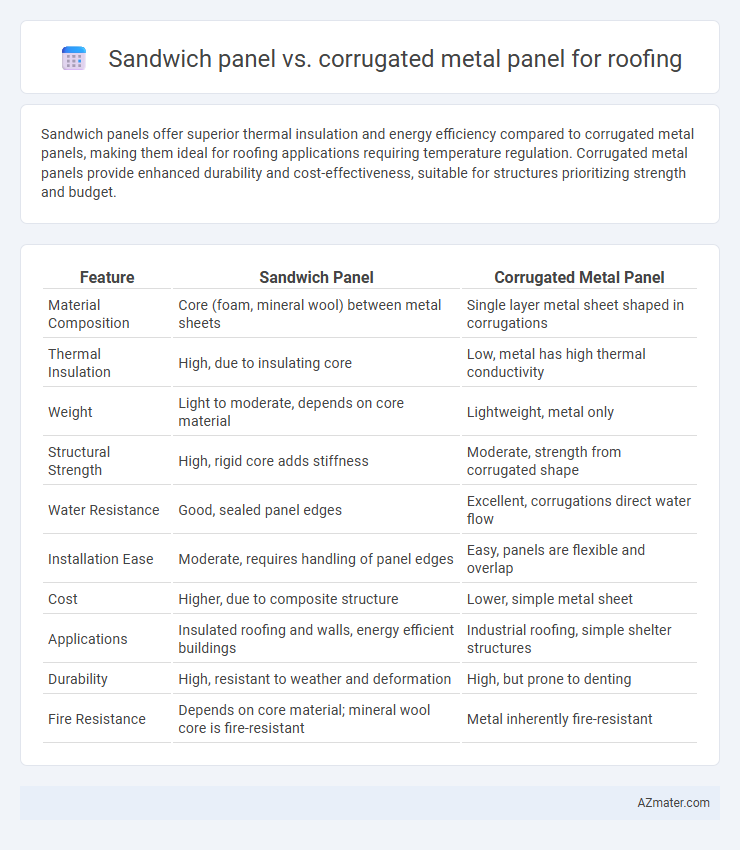Sandwich panels offer superior thermal insulation and energy efficiency compared to corrugated metal panels, making them ideal for roofing applications requiring temperature regulation. Corrugated metal panels provide enhanced durability and cost-effectiveness, suitable for structures prioritizing strength and budget.
Table of Comparison
| Feature | Sandwich Panel | Corrugated Metal Panel |
|---|---|---|
| Material Composition | Core (foam, mineral wool) between metal sheets | Single layer metal sheet shaped in corrugations |
| Thermal Insulation | High, due to insulating core | Low, metal has high thermal conductivity |
| Weight | Light to moderate, depends on core material | Lightweight, metal only |
| Structural Strength | High, rigid core adds stiffness | Moderate, strength from corrugated shape |
| Water Resistance | Good, sealed panel edges | Excellent, corrugations direct water flow |
| Installation Ease | Moderate, requires handling of panel edges | Easy, panels are flexible and overlap |
| Cost | Higher, due to composite structure | Lower, simple metal sheet |
| Applications | Insulated roofing and walls, energy efficient buildings | Industrial roofing, simple shelter structures |
| Durability | High, resistant to weather and deformation | High, but prone to denting |
| Fire Resistance | Depends on core material; mineral wool core is fire-resistant | Metal inherently fire-resistant |
Introduction to Roofing Panel Options
Sandwich panels consist of a core insulation layer bonded between two metal sheets, offering superior thermal insulation and structural strength for roofing applications. Corrugated metal panels feature a wavy pattern that enhances durability and water runoff, making them cost-effective and easy to install. Choosing between these roofing panel options depends on factors like energy efficiency, budget, and climate conditions.
What is a Sandwich Panel?
A sandwich panel is a composite roofing material consisting of two metal sheets bonded to a core insulating material, typically polyurethane or polystyrene, offering superior thermal insulation and structural strength. This design enhances energy efficiency and reduces noise transmission compared to traditional corrugated metal panels, which are single-layered and primarily provide basic weather protection. Sandwich panels are ideal for applications requiring enhanced durability, insulation, and aesthetic appeal in roofing systems.
What is a Corrugated Metal Panel?
A corrugated metal panel is a roofing material characterized by its repetitive wave-like ridges that enhance strength and durability while providing effective water drainage. Commonly fabricated from steel or aluminum, these panels offer resistance to harsh weather conditions, corrosion, and fire, making them ideal for both commercial and industrial roofing applications. Their lightweight nature and ease of installation contribute to reduced labor costs and faster project completion compared to traditional roofing systems.
Material Composition Comparison
Sandwich panels consist of a core insulating material such as polyurethane or polystyrene, sandwiched between two metal sheets, offering superior thermal insulation and structural strength compared to corrugated metal panels. Corrugated metal panels are typically made from galvanized steel or aluminum, providing durability and resistance to weather but lacking the integrated insulation properties found in sandwich panels. The composite structure of sandwich panels enhances energy efficiency in roofing applications, while corrugated metal panels prioritize flexibility and ease of installation.
Insulation and Thermal Efficiency
Sandwich panels feature a core of insulating material such as polyurethane or polystyrene, providing superior thermal efficiency by minimizing heat transfer compared to corrugated metal panels. Corrugated metal panels, typically made of steel or aluminum, offer limited insulation unless paired with separate insulating layers, resulting in higher thermal conductivity. The inherent insulation properties of sandwich panels make them ideal for energy-efficient roofing applications where maintaining consistent indoor temperatures is critical.
Installation Process and Complexity
Sandwich panels offer a streamlined installation process due to their pre-insulated structure, allowing for fewer components and faster assembly compared to corrugated metal panels, which require additional insulation and fastening steps. The lightweight nature of sandwich panels reduces labor intensity and time on site, minimizing complexity and installation errors. Corrugated metal panels, while durable, involve more precise alignment and sealing techniques to ensure weatherproofing, increasing the overall installation complexity and time.
Durability and Weather Resistance
Sandwich panels offer superior insulation and enhanced durability due to their multi-layer construction, making them highly resistant to extreme weather conditions such as heavy rain, snow, and strong winds. Corrugated metal panels provide excellent longevity and are resistant to rust and corrosion when properly coated, but they may lack the thermal insulation properties of sandwich panels. Both materials resist UV radiation effectively, with sandwich panels often outperforming in preventing thermal bridging and moisture intrusion.
Cost Analysis: Sandwich vs Corrugated Panels
Sandwich panels typically cost more upfront than corrugated metal panels due to their multi-layered insulation and higher manufacturing complexity, making them a better investment for energy efficiency and long-term savings. Corrugated metal panels offer a lower initial price but may incur higher maintenance and energy costs over time due to lower insulation properties. Evaluating lifecycle costs, sandwich panels provide improved thermal performance and structural integrity, offsetting their higher initial price compared to the budget-friendly corrugated metal roofing options.
Maintenance and Longevity
Sandwich panels offer superior insulation and durability, requiring minimal maintenance due to their composite structure that resists corrosion and weather damage. Corrugated metal panels, while cost-effective and easy to install, often demand regular upkeep such as repainting and rust prevention to extend their lifespan. Longevity of sandwich panels typically surpasses that of corrugated metal, lasting up to 40 years compared to an average of 20-30 years for corrugated roofing when properly maintained.
Choosing the Best Panel for Your Roofing Needs
Sandwich panels offer superior thermal insulation and enhanced energy efficiency compared to corrugated metal panels, making them ideal for environments with extreme temperature variations. Corrugated metal panels provide exceptional durability and cost-effectiveness, suitable for projects prioritizing budget and structural strength. Evaluating factors such as insulation requirements, budget constraints, and long-term maintenance helps determine the most appropriate roofing panel for your specific needs.

Infographic: Sandwich panel vs Corrugated metal panel for Roofing
 azmater.com
azmater.com